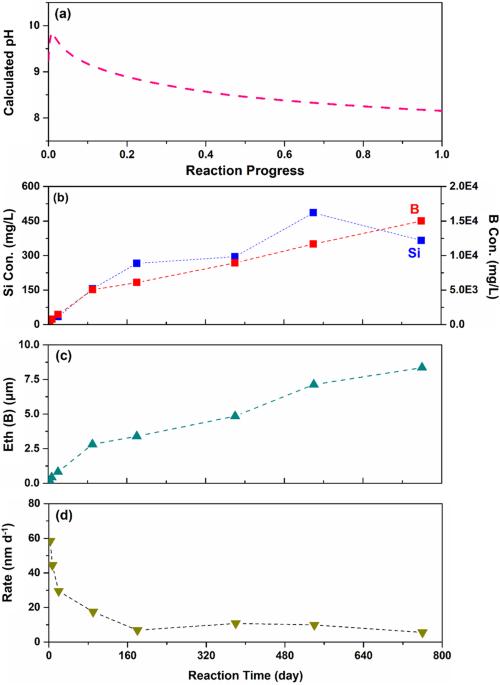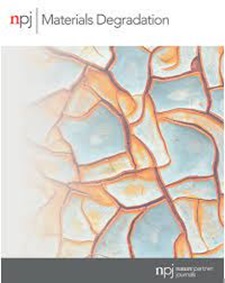孔隙水中硼硅玻璃腐蚀过程中次生相和表面蚀变层的形成与演化
IF 6.6
2区 材料科学
Q1 MATERIALS SCIENCE, MULTIDISCIPLINARY
引用次数: 0
摘要
硼硅玻璃在水腐蚀过程中产生的次生相和表面改质层(SAL)对其化学耐久性有很大影响。然而,这些结构的形成和演变仍不清楚。在此,通过研究硼硅玻璃在 90 °C 时孔隙水(玻璃粉之间孔隙中的水分)的变化,次生相的形成可能有两种途径:1.水离子的消耗在玻璃表面形成安石灰、沸石、硅酸钙和重晶石;2.二氧化硅聚集体的重组导致在 SAL 内部形成闪长岩。小角 X 射线散射和横截面扫描电子显微镜研究结果表明,可溶性元素的释放和 SAL 中烟晶石的形成显著增加了 SAL 的孔隙率。此外,随着时间的推移,含有闪长岩的层向内重组,闪长岩的结晶度逐渐增加。透射电子显微镜的观察结果表明,玻璃的溶解可能经历了一个界面耦合的溶解-再沉淀过程。本文章由计算机程序翻译,如有差异,请以英文原文为准。

Formation and evolution of secondary phases and surface altered layers during borosilicate glass corrosion in pore water
The emergent secondary phases and surface altered layer (SAL) during the aqueous corrosion of borosilicate glass have a great impact on its chemical durability. However, the formation and evolution of these structures are still unclear. Here, by studying the borosilicate glass altered at 90 °C in pore water, the water in pore space between glass powders, the formation of secondary phases could follow two ways: 1. the consumption of aqueous ions forms analcime, zeolite, calcium silicate and barite at the surface of glass; 2. the reorganization of silica aggregates leads to smectite within the SAL. Small-angle X-ray scattering and cross-sectional scanning electron microscopy results show that the release of soluble elements and the formation of smectite within the SAL significantly increase the porosity of SAL. Furthermore, the layer containing smectite reorganizes inwardly and the crystallinity of smectite is gradually increased over time. The observations of transmission electron microscopy reveal that the dissolution of glass potentially goes through an interface-coupled dissolution-reprecipitation process.
求助全文
通过发布文献求助,成功后即可免费获取论文全文。
去求助
来源期刊

npj Materials Degradation
MATERIALS SCIENCE, MULTIDISCIPLINARY-
CiteScore
7.80
自引率
7.80%
发文量
86
审稿时长
6 weeks
期刊介绍:
npj Materials Degradation considers basic and applied research that explores all aspects of the degradation of metallic and non-metallic materials. The journal broadly defines ‘materials degradation’ as a reduction in the ability of a material to perform its task in-service as a result of environmental exposure.
The journal covers a broad range of topics including but not limited to:
-Degradation of metals, glasses, minerals, polymers, ceramics, cements and composites in natural and engineered environments, as a result of various stimuli
-Computational and experimental studies of degradation mechanisms and kinetics
-Characterization of degradation by traditional and emerging techniques
-New approaches and technologies for enhancing resistance to degradation
-Inspection and monitoring techniques for materials in-service, such as sensing technologies
 求助内容:
求助内容: 应助结果提醒方式:
应助结果提醒方式:


